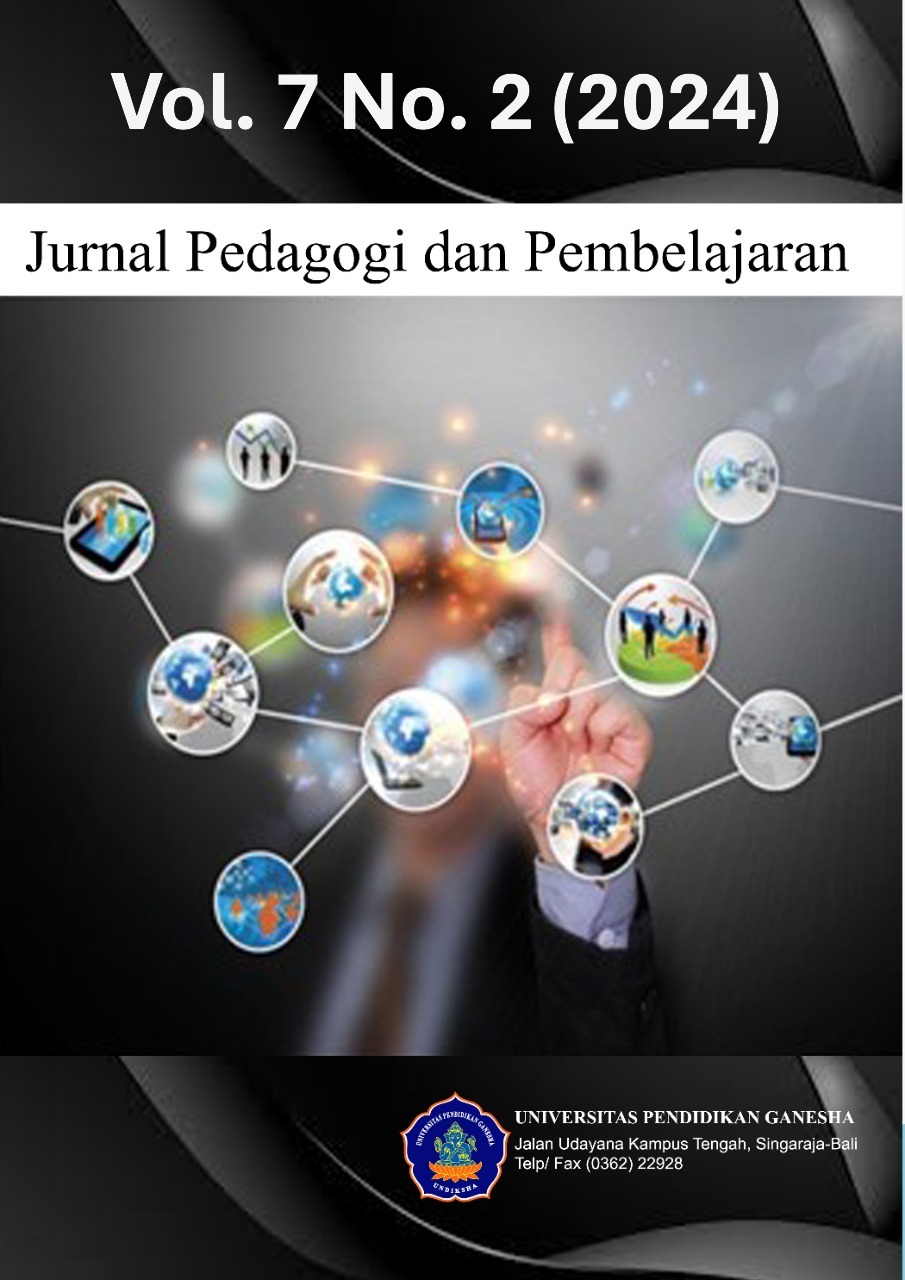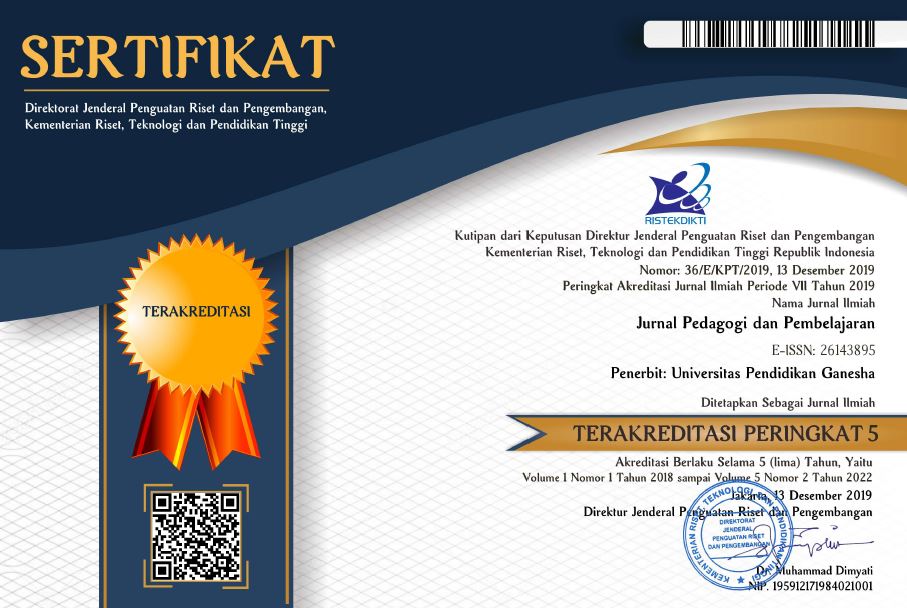Profile of Students Creative Thinking Skills and Implementation of Inquiry-based Learning Assisted by Physics 3D Module
DOI:
https://doi.org/10.23887/jp2.v7i2.68112Keywords:
Inquiry Based Learning, Creative Thinking Skills, Elasticity, Hooke's LawAbstract
So far in physics subjects, especially material that contain many formulas, students have complained about difficulties in accepting the material. This is because the learning model and learning media used are still not in accordance with the material provided. The study aimed to analyze surveys about learning model used in physics lesson and tests using indicators of creative thinking ability specially on the material elasticity. This research is preliminary research with a descriptive research design. This research does not use a hypothetical test design but rather a description research project. The study was conducted on 181 students consisting of: 78 male students and 103 female students. The study uses three instruments to gather data, i.e. a.) a creative thinking test instrument of four indicators flexibility, elaboration, originality and fluency on material elasticity and Hooke law, b.) teacher interview sheet about learning model used in physics lesson, c.) student questionnaire about perspective of physics lesson, learning models and learning media. The results showed the creative thinking ability of students still belongs to the low category. The implication is that teachers must be able to apply appropriate learning models and learning media in the process so that students are able to receive the material well and have the ability to think creatively.
References
Agung, A., Amin, B. D., Yani, A., & Swandi, A. (2019). Pengembangan Bahan Ajar Berbasis E-Learning Mata Kuliah Fisika Dasar pada Jurusan Biologi FMIPA UNM. Indonesian Journal of Educational Studies, 21(2). https://doi.org/10.26858/ijes.v21i2.8644. DOI: https://doi.org/10.26858/ijes.v21i2.8644
Amin, S., Sumarmi, Bachri, S., Susilo, S., & Bashith, A. (2020). The Effect of Problem-Based Hybrid Learning (PBHL) Models on Spatial Thinking Ability and Geography Learning Outcomes. International Journal of Emerging Technologies in Learning, 15(19), 83–94. https://doi.org/10.3991/ijet.v15i19.15729. DOI: https://doi.org/10.3991/ijet.v15i19.15729
Andrian, Y., & Rusman, R. (2019). Implementasi pembelajaran abad 21. Jurnal Penelitian Ilmu Pendidikan, 12(1), 14–23. https://journal.uny.ac.id/index.php/jpip/article/view/20116. DOI: https://doi.org/10.21831/jpipfip.v12i1.20116
Avando Bastari, Adi Bandono, & Okol Sri Suharyo. (2021). The development strategy of smart campus for improving excellent navy human resources. Global Journal of Engineering and Technology Advances, 6(2), 033–043. https://doi.org/10.30574/gjeta.2021.6.2.0011. DOI: https://doi.org/10.30574/gjeta.2021.6.2.0011
Basyoni, A., Bee, M., S., H., Seng, G., & H. (2020). The effectiveness of using students’ created digital storytelling in enhancing Saudi ninth graders’ critical listening skills. Journal of Education and Social Sciences, 16(1), 58–72. https://doi.org/https://www.jesoc.com/wp-content/uploads/2020/12/JESOC16-030.pdf.
Cahyana, U., Kadir, A., & Gherardini, M. (2017). Relasi Kemampuan Berpikir Kritis Dalam Kemampuan Literasi Sains Pada Siswa Kelas Iv Sekolah Dasar. Sekolah Dasar: Kajian Teori Dan Praktik Pendidikan, 26(1), 14–22. https://doi.org/10.17977/um009v26i12017p014. DOI: https://doi.org/10.17977/um009v26i12017p014
Darmaji, Astalini, Kurniawan, D. A., & Widodi, B. (2022). The relationship between science process skills and students’ creative thinking skills at the Nurul Ilmi 1 Islamic Junior High School on Magnetism material. Jurnal Pedagogi Dan Pembelajaran, 3(5). https://doi.org/10.23887/jp2.v5i3.48636. DOI: https://doi.org/10.23887/jp2.v5i3.48636
Diah Ratna Sari, K. A., Ngurah Wiyasa, K., & Ganing, N. N. (2018). Pengaruh Model Pembelajaran Inkuiri Terbimbing Berbantuan Media Konkret Terhadap Kompetensi Pengetahuan Ipa. Mimbar Ilmu, 23(2), 165–173. https://doi.org/10.23887/mi.v23i2.16416. DOI: https://doi.org/10.23887/mi.v23i2.16416
Dian Christi, R. Y., Handhika, J., & Yusro, A. C. (2020). Pengembangan Modul Fisika Berbasis OASIS Pada Materi Suhu dan Kalor Untuk Meningkatkan Kemampuan Berpikir Kritis. Radiasi : Jurnal Berkala Pendidikan Fisika, 13(2), 55–60. https://doi.org/10.37729/radiasi.v13i2.296. DOI: https://doi.org/10.37729/radiasi.v13i2.296
Fatimah, A. S., & Santiana, S. (2017). Teaching in 21St Century: Students-Teachers’ Perceptions of Technology Use in the Classroom. Script Journal: Journal of Linguistic and English Teaching, 2(2), 125. https://doi.org/10.24903/sj.v2i2.132. DOI: https://doi.org/10.24903/sj.v2i2.132
Firdaus, A., Asikin, M., & Agoestanto, A. (2021). Kemampuan Berpikir Kreatif pada Model Learning Cycle 5E Ditinjau dari Metakognisi Siswa. AKSIOMA: Jurnal Matematika Dan Pendidikan Matematika, 12(3), 382–398. https://doi.org/10.33603/jnpm.v7i2.8128. DOI: https://doi.org/10.33603/jnpm.v7i2.8128
Gorghiu, G., Drăghicescu, L. M., Cristea, S., Petrescu, A.-M., & Gorghiu, L. M. (2015). Problem-based Learning - An Efficient Learning Strategy in the Science Lessons Context. Procedia - Social and Behavioral Sciences, 191, 1865–1870. https://doi.org/https://doi.org/10.1016/j.sbspro.2015.04.570. DOI: https://doi.org/10.1016/j.sbspro.2015.04.570
Haryati Mahyudin, E. M. (2022). Penerapan Metode Inkuiri Untuk Meningkatkan Minat Belajar Peserta Didik Kelas XI MAS Al-Ikhwan Gotowasi Pada Konsep Usaha. Jurnal Ilmiah Wahana Pendidikan Https://Jurnal.Unibrah.Ac.Id/Index.Php/JIWP, 8(3), 178–183. https://doi.org/10.5281/zenodo.6586251.
K. Yani, U. . . (2016). Pengaruh Penerapan Metode Pembelajaran Inkuiri Terhadap Peningkatan Kemampuan Berpikir Kreatif (pp. 86–90).
Kurniati, F., Soetjipto, S., & Indana, S. (2018). Membangun Keterampilan Berpikir Kreatif Siswa Melalui Pembelajaran Berbasis Inkuiri Terbimbing. Jurnal Penelitian Pendidikan IPA, 3(1), 15–20. https://doi.org/10.26740/jppipa.v3n1.p15-20. DOI: https://doi.org/10.26740/jppipa.v3n1.p15-20
Leasa, M., Batlolona, J. R., & Talakua, M. (2021). Elementary students ’ creative thinking skills in science in the Maluku Islands, Indonesia. Creativity Studies, 14(1), 74–89. https://doi.org/10.3846/cs.2021.11244. DOI: https://doi.org/10.3846/cs.2021.11244
Lestari, F., Egok, A. S., & Febriandi, R. (2021). Pengembangan Bahan Ajar Matematika Berbasis Problem Based Learning Pada Siswa Sekolah Dasar. Jurnal Basicedu, 5(1), 394–405. https://doi.org/10.31004/basicedu.v5i1.628. DOI: https://doi.org/10.31004/basicedu.v5i1.628
Moma, L. (2017). Pengembangan Kemampuan Berpikir Kreatif Dan Pemecahan Masalah Matematis Mahasiswa Melalui Metode Diskusi. Jurnal Cakrawala Pendidikan, 36(1), 130–139. https://doi.org/10.21831/cp.v36i1.10402. DOI: https://doi.org/10.21831/cp.v36i1.10402
Nurlaela, L., Suparji, S., Budi, K., Pratama, S., & Irawati, Y. (2018). Inquiry-Based Learning to Studentsr Creative Thinking Skills in Vocational High School. International Conference on Indonesian Technical Vocational Education and Association (APTEKINDO 2018), 201(Aptekindo), 87–90. https://doi.org/10.2991/aptekindo-18.2018.19. DOI: https://doi.org/10.2991/aptekindo-18.2018.19
Octavia. (2019). Guided Inquiry-Based Learning to Train Creative Thinking Skills of Students ( High School ).
Primayonita, N. K. K., Agustiana, I. G. A. T., & Jayanta, I. N. L. (2020). Model Creativity Learning Meningkatkan Keterampilan Berpikir Kreatif dan Tanggung Jawab Pada Mata Pelajaran IPA. Jurnal Pedagogi Dan Pembelajaran, 3(2), 211. https://doi.org/10.23887/jp2.v3i2.26551. DOI: https://doi.org/10.23887/jp2.v3i2.26551
Putri, I. K., & Hutahaean, J. (2019). Implementasi Model Pembelajaran Inquiry Training Terhadap Hasil Belajar Siswa Di Kelas X SMA. Jurnal Ikatan Alumni Fisika, 5(4), 47–51. https://doi.org/10.24114/jiaf.v5i4.15988. DOI: https://doi.org/10.24114/jiaf.v5i4.15988
Putri, Y. A., Usman, A., & Cahyati, M. T. (2019). Meta-Analisis Pengaruh penggunaan Model Inquiry Based Learning terhadap Kompetensi Keterampilan Peserta Didik dalam Pembelajaran Fisika. Jurnal Penelitian Pembelajaran Fisika, 5(1), 65–72. https://ejournal.unp.ac.id/index.php/jppf/article/view/107423.
Rahmatsyah, S. W., & Dwiningsih, K. (2021). Development of Interactive E-Module on The Periodic System Materials as an Online Learning Media. Jurnal Penelitian Pendidikan IPA, 7(2), 255. https://doi.org/10.29303/jppipa.v7i2.582. DOI: https://doi.org/10.29303/jppipa.v7i2.582
Ramadayanty, M., Sutarno, S., & Risdianto, E. (2021). Pengembangan E-Modul Fisika Berbasis Multiple Reprsentation Untuk Melatihkan Keterampilan Pemecahan Masalah Siswa. Jurnal Kumparan Fisika, 4(1), 17–24. https://doi.org/10.33369/jkf.4.1.17-24. DOI: https://doi.org/10.33369/jkf.4.1.17-24
Santosa, A. S. E., ., Gede Saindra Santyadiputra, S.T., M. C., & ., Dr. Dewa Gede Hendra Divayana, S.Kom., M. (2017). Pengembangan E-Modul Berbasis Model Pembelajaran Problem Based Learning Pada Mata Pelajaran Administrasi Jaringan Kelas Xii Teknik Komputer Dan Jaringan Di Smk Ti Bali Global Singaraja. Kumpulan Artikel Mahasiswa Pendidikan Teknik Informatika (KARMAPATI), 6(1), 62. https://doi.org/10.23887/karmapati.v6i1.9269. DOI: https://doi.org/10.23887/karmapati.v6i1.9269
Saputri, M., & Syukri, M. (2022). Analysis of momentum and impulse on students’ creative thinking skill through project based learning integrated STEM (science, technology, engineering, mathematics). In Journal of Physics: Conference Series, 2193(1), 012066. https://doi.org/10.1088/1742-6596/2193/1/012066/meta. DOI: https://doi.org/10.1088/1742-6596/2193/1/012066
Sofyan, H., Anggereini, E., & Saadiah, J. (2019). Development of E-Modules Based on Local Wisdom in Central Learning Model at Kindergartens in Jambi City. European Journal of Educational Research, 8(4), 1137–1143. https://doi.org/10.12973/eu-jer.8.4.1137. DOI: https://doi.org/10.12973/eu-jer.8.4.1139
Srifitriani, A., Regita, S. M., & ... (2022). Implementasi Metode Inquiry Based Learning Dalam Meningkatkan Creative Thinking Skills. Psikodidaktika: Jurnal Ilmu Pendidikan, Psikologi, Bimbingan Dan Konseling, 7(02), 349–357. https://journals.unihaz.ac.id/index.php/psikodidaktika/article/view/3145.
Sumarli, S., & Rosdianto, H. (2022). Correlation of Science Process Skills with Students’ Creativity in Learning of Creative Problem Solving Model with an Inquiry Approach on the Simple Harmonic Motion. Jurnal Ilmu Pendidikan Fisika, 7(1), 94–101. https://ejournal.unp.ac.id/index.php/jppf/article/view/107423. DOI: https://doi.org/10.26737/jipf.v7i1.2597
Taufiq, M., Ghani, A., Hamzah, M., Ramli, S., Ab, W., Daud, A. W., Rijal, T., Romli, M., Najihah, N., & Mokhtar, M. (2019). a Questionnaire-Based Approach on Technology Acceptance Model for Mobile Digital Game-Based Learning. Journal of Global Business and Social Entrepreneurship (GBSE), 5(14), 24621714. http://www.gbse.my/V5 NO.14 (MARCH 2019)/Paper-199-.pdf.
Winarni, R., Slamet, S. Y., & Syawaludin, A. (2022). Development of Indonesian language text books with multiculturalism and character education to improve traditional poetry writing skills. European Journal of Educational Research, 10(1), 455–466. https://doi.org/10.12973/EU-JER.10.1.455. DOI: https://doi.org/10.12973/eu-jer.10.1.455
Winarti, T., Fatirul, A. N., & Hartono, H. (2020). Model Pembelajaran Problem based Learning, Inkuiri Terbimbing, dan Learing Creativity Berpengaruh terhadap Prestasi Belajar Matematika. Jurnal Pedagogi Dan Pembelajaran, 3(3), 387–396. https://doi.org/10.23887/jp2.v3i3.29063.
Downloads
Published
How to Cite
Issue
Section
License
Copyright (c) 2024 Nabillah Zuhrotun Nisa, Binar Kurnia Prahani, Marianus, Irwanto, Muhammed Akif Kurtulus, Muhammad Nur Hudha

This work is licensed under a Creative Commons Attribution-ShareAlike 4.0 International License.
Authors who publish with Jurnal Pedagogi dan Pembelajaran agree to the following terms:
- Authors retain copyright and grant the journal the right of first publication with the work simultaneously licensed under a Attribution-ShareAlike 4.0 International (CC BY-SA 4.0) that allows others to share the work with an acknowledgment of the work's authorship and initial publication in this journal
- Authors are able to enter into separate, additional contractual arrangements for the non-exclusive distribution of the journal's published version of the work (e.g., post it to an institutional repository or publish it in a book), with an acknowledgment of its initial publication in this journal.
- Authors are permitted and encouraged to post their work online (e.g., in institutional repositories or on their website) prior to and during the submission process, as it can lead to productive exchanges, as well as earlier and greater citation of published work. (See The Effect of Open Access)











